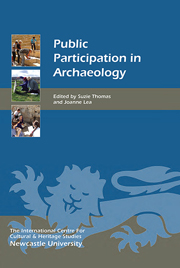Book contents
- Frontmatter
- Dedication
- Contents
- List of Illustrations
- Acknowledgments
- List of Abbreviations
- Preface
- Introduction
- Public Participation in Archaeology: International Models
- Public Participation in Archaeology Through Education
- Public Participation in Archaeology Through Tourism
- Public Participation in Archaeology Through Site Management and conservation
- 13 ‘They are hiding it … Why do they hide it? From whom, and for whom?’ Community Heritage at Work in the Post-Colonial Context of Jordan
- 14 Site Management in Turkey
- 15 Adopt a Monument: Social Meaning from Community Archaeology
- 16 Public Archaeology in canada
- List of Contributors
- Index
16 - Public Archaeology in canada
from Public Participation in Archaeology Through Site Management and conservation
Published online by Cambridge University Press: 05 August 2014
- Frontmatter
- Dedication
- Contents
- List of Illustrations
- Acknowledgments
- List of Abbreviations
- Preface
- Introduction
- Public Participation in Archaeology: International Models
- Public Participation in Archaeology Through Education
- Public Participation in Archaeology Through Tourism
- Public Participation in Archaeology Through Site Management and conservation
- 13 ‘They are hiding it … Why do they hide it? From whom, and for whom?’ Community Heritage at Work in the Post-Colonial Context of Jordan
- 14 Site Management in Turkey
- 15 Adopt a Monument: Social Meaning from Community Archaeology
- 16 Public Archaeology in canada
- List of Contributors
- Index
Summary
Background
The structure under which archaeology in Canada is governed and undertaken is fragmented due to history, geography and venue of practice (eg academia, avocational organisation, museum, private company). Canada is a multicultural and bilingual society by law (Canadian Multiculturalism Act (RSC, 1985, c 24); Official Languages Act RSC, 1988, c 31), with different linguistic and cultural regions. As a result, the jurisdiction for cultural heritage has been safeguarded regionally, ie at the provincial or territorial level (Moore 1997, 126, 238). There are ten provinces and three territories, each of which has separate heritage legislation and guidelines for archaeology. Museums, universities and avocational groups for archaeology in each province or territory also developed regionally, without a national focus. The federal government is responsible for national import and export legislation as it relates to artefacts, relations with First Nations and archaeological heritage on federal lands such as National Parks and National Historic Sites through the Parks Canada Agency and the Archaeological Survey of Canada (Burley 1994, 83). The national museum — currently called The Canadian Museum of Civilization (CMC) — is a crown corporation. There is no national heritage legislation.
Public archaeology in Canada developed in this fragmented environment. The term ‘public archaeology’ has been broadly defined in the Canadian context as ‘virtually all professional archaeology … funded directly or indirectly with public monies and mandated by publicly supported legislation’ (Smardz and Smith 2000, 27).
- Type
- Chapter
- Information
- Public Participation in Archaeology , pp. 183 - 194Publisher: Boydell & BrewerPrint publication year: 2014

